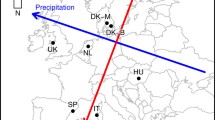Abstract
Classical concepts view succession as a deterministic, mechanistic regeneration of the disturbed community, and thus have limited applicability to fire-prone ecosystems, A recently developed multiple pathway succession model appears to have more realism and applicability in frequently disturbed ecosystems. It includes a set of species-specific attributes that are vital to reproduction and survival, and permits variable succession pathways depending on the stand's age (and thus species composition) when disturbed. Examples from Australia and the northern Rocky Mountains (USA) are presented, as are approaches to refining and improving the model.
Similar content being viewed by others
Literature cited
Botkin, D. B., J. F. Janak, and J. R. Wallis. 1972. Some ecological consequences of a computer model of forest growth. J. Ecol. 60:849–872.
Clements, F. E. 1916. Plant succession: an analysis of the development of vegetation. Carnegie Instn. Pub. No. 242. 512 pp.
Connell, J. H., and R. O. Slatyer. 1977. Mechanisms of succession in natural communities and their role in community stability and organization. Amer. Natur. 111:1119–1144.
Franklin, J. F. 1968. Cone production by upper-slope conifers. USDA Forest Service Res. Paper PNW-60. 21 pp.
Franklin, J. F., R. Carkin, and J. Booth. 1974. Seeding habits of upper-slope tree species. I. A 12-year record of cone production. USDA Forest Service Res. Note PNW-213. 12 pp.
Franklin, J. F., and C. E. Smith. 1974a. Seeding habits of upper-slope tree species. II. Dispersal of a mountain hemlock seedcrop on a clearcut. USDA Forest Service Res. Note PNW-214. 9 pp.
—. 1974b. Seeding habits of upper-slope tree species. III. Dispersal of white and Shasta red fir seeds on a clearcut. USDA Forest Service Res. Note PNW-215. 9 pp.
Gill, A. M. 1977. Plant traits adaptive to fires in Mediterranean land ecosystems. Pages 17–26.in Proc. of the symp. on the environ. consequences of fire and fuel manag. in Mediterranean climate ecosystems. USDA Forest Service Gen. Tech. Rep. WO-3.
Horn, H. S. 1974. Succession. Pages 187–204in R. M. May, ed. Theoretical ecology: principles and applications. Blackwell Seien. Pub., Oxford.
Kessell, S. R. 1976. Gradient modeling: a new approach to fire modeling and wilderness resource management. Environmental Management 1(1):39–48.
—. 1977. Gradient modeling: a new approach to fire modeling and resource management. Pages 575–605in C. A. S. Hall and J. W. Day, Jr., eds. Ecosystem modeling in theory and practice: an introduction with case histories. Wiley, New York.
—. 1979a. Phytosociological inference and resource management. Environmental Management 3(1):29–40.
—. 1979b. Gradient modeling (Springer Series on Environmental Management). Springer-Verlag, New York. in press.
Noble, I. R., and R. O. Slatyer. 1977. Post-fire succession of plants in Mediterranean ecosystems. Pages 27–36in Proc. of the symp. on the environ. consequences of fire and fuel manag. in Mediterranean climate ecosystems. USDA Forest Service Gen. Tech. Rep. WO-3.
Odum, E. P. 1969. The strategy of ecosystem development. Science 164:262–270.
Singer, F. A. 1975. Wildfire and ungulates in the Glacier National Park area, northwestern Montana. Masters thesis, Univ. of Idaho, Moscow. 53 pp.
Vogl, R. J. 1977. Fire frequency and site degradation. Pages 193–201in Proc. of the symp. on the environ. consequences of fire and fuel manag. in Mediterranean climate ecosystems. USDA Forest Service Gen. Tech. Rep. WO-3.
Walter, H. 1977. Effects of fire on wildlife communities. Pages 183–192in Proc. of the symp. on the environ. consequences of fire and fuel manag. in Mediterranean climate ecosystems. USDA Forest Service Gen. Tech. Rep. WO-3.
Whittaker, R. H. 1975. Functional aspects of succession in deciduous forests. Pages 377–405in R. Tuxen, ed. Sukzessionsforschung Ber. Int. Sympos. Rinteln 1973.
Author information
Authors and Affiliations
Rights and permissions
About this article
Cite this article
Cattelino, P.J., Noble, I.R., Slatyer, R.O. et al. Predicting the multiple pathways of plant succession. Environmental Management 3, 41–50 (1979). https://doi.org/10.1007/BF01867067
Issue Date:
DOI: https://doi.org/10.1007/BF01867067




